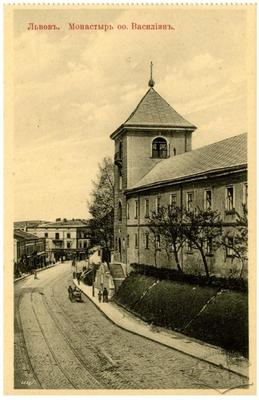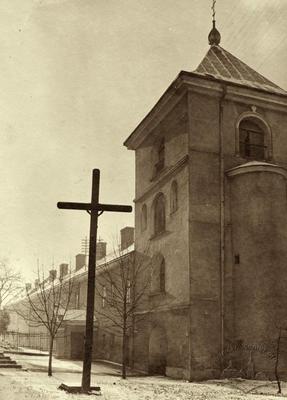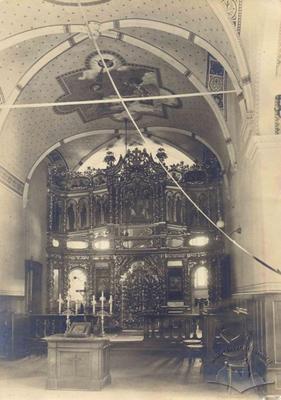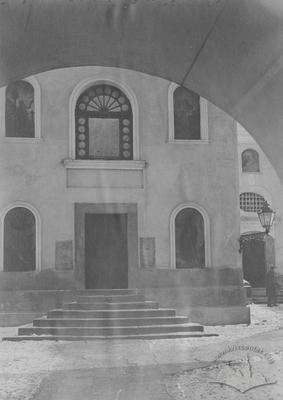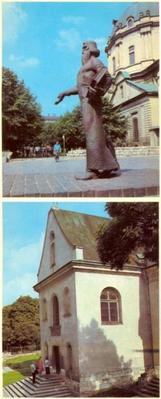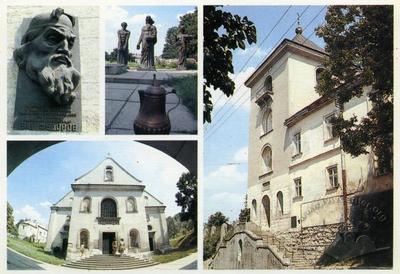Vul. Khmelnytskoho, 036 – The St. Onuphrius Church of the Basilian Monastery
ID:
174
The St. Onuphrius monastery in Lviv consists of a complex of buildings including a church, a belfry gate and monks’ cells which are owned by the Most Holy Saviour Province of the Basilian Order in Ukraine. It is located in the oldest part of the city existing since the times of the Principality of Galicia-Volhynia. The church is one of the oldest monastery churches; it is associated with well-known historical persons (a prince of Moldavia), clerics, members of the Lviv Stauropegion brotherhood, noted architects (Franz Trescher, Edgar Kováts), sculptors, carvers (Andriy Koverko), painters (Luka Dolynsky, Marcin Jabłonski, Modest Sosenko), printing pioneer Ivan Fedorovych (Fedorov). Some prominent figures of the sixteenth-eighteenth centuries from Lviv and Ukraine are buried in the church and near it.
According to the resolution of the Council of Ministers of the Ukrainian SSR number 970 dated 24 August 1963, the St. Onuphrius church was entered in the National list of monuments under protection number 364/1.
According to the resolution of the Council of Ministers of the Ukrainian SSR number 970 dated 24 August 1963, the St. Onuphrius church was entered in the National list of monuments under protection number 364/1.
Architecture
The church is situated to the north from the historical center, in the oldest part of the city existing since the times of the Principality of Galicia-Volhynia, on the western slope of the Zamkova (Castle) mountain. It lies within the limits of the historical area and the UNESCO zone. This architectural monument is the dominant of the oldest, “princely” part of the city.
The church is built of hewn stone and plastered. As for its volume and composition structure, it has three naves with faceted altar apses, an elongated altar and a babynets of the same shape. Rectangular sacristies adjoin the short side naves symmetrically on both sides of the altar. A semicircular shaft of stairs, leading to the choir loft and to the roof, projects in the northern wall of the babynets. All blocks are covered with high double-pitch roofs. The crest of the central nave is crowned with a delicate octahedral flèche; the side naves are crowned with helmet-like domes lying on low octahedral tholobates which are crowned with blind masonry lanterns having small cupolas. The façades of all blocks are crowned with shaped cornices and divided by pilasters; they are cut through with semicircular window openings having shaped framings and keystones. Three blocks on the main façade are accentuated by triangular pediments and entrance portals with oval windows over the side entrances and a big semicircular window and the date “1518” over the central entrance. The white stone portals of the side naves are made in the Renaissance style. The central part is decorated with four icons located in semicircular niches, those of SS. Peter and Paul on the first tier and those of the Most Holy Mother of God and Christ on the second tier. In small semicircular niches on the western side façades, icons of the Nativity of Christ (north) and the Baptism of Christ (south) are located, with symbols of the Passion (south) and the monogram of Mary (north). Each entrance has stairs leading to it; the central stairs are decorated with a skillfully made handrail.
In the interior, the main nave is bridged with a cross vault; the western part of the main nave over the choir loft and the altar part are bridged with semicircular lunette vaults; the apse has a starred vault. The U-type choir loft in the babynets leans on white stone cantilevers and has a forged railing. The space of the side naves in the interior is opened up to the base of the lanterns over the domes; the western parts are bridged with cross vaults, the apses are bridged with starred vaults. The naves are connected by arch openings (two on each side). The walls are covered with subject and ornamental paintings; the floor is paved with black and white ceramic tiles in staggered rows. The soleas of all the three altars are fenced with wooden carved balustrades. In the former entrance to the sacristy (in the main nave southern wall), a niche is arranged with a contemporary St. Onuphrius sculpture of little value. Wooden tambours are made at all entrances from the main façade. The interior arrangement of the late nineteenth and early twentieth centuries (iconostasis, side altars, altarpiece, some icons, synthronon, the main altar with the tabernacle, confessional) has been preserved in the church; it is supplemented with new small side altars. The roof constructions over the main nave consist of wooden rafters with beams which are fastened with oak trunnels.
The church is an interesting pattern of old Ukrainian architecture which has some features of different periods, those of Renaissance (the Holy Trinity chapel portal), Baroque, Neo-Classicism, Art Nouveau.
The church is built of hewn stone and plastered. As for its volume and composition structure, it has three naves with faceted altar apses, an elongated altar and a babynets of the same shape. Rectangular sacristies adjoin the short side naves symmetrically on both sides of the altar. A semicircular shaft of stairs, leading to the choir loft and to the roof, projects in the northern wall of the babynets. All blocks are covered with high double-pitch roofs. The crest of the central nave is crowned with a delicate octahedral flèche; the side naves are crowned with helmet-like domes lying on low octahedral tholobates which are crowned with blind masonry lanterns having small cupolas. The façades of all blocks are crowned with shaped cornices and divided by pilasters; they are cut through with semicircular window openings having shaped framings and keystones. Three blocks on the main façade are accentuated by triangular pediments and entrance portals with oval windows over the side entrances and a big semicircular window and the date “1518” over the central entrance. The white stone portals of the side naves are made in the Renaissance style. The central part is decorated with four icons located in semicircular niches, those of SS. Peter and Paul on the first tier and those of the Most Holy Mother of God and Christ on the second tier. In small semicircular niches on the western side façades, icons of the Nativity of Christ (north) and the Baptism of Christ (south) are located, with symbols of the Passion (south) and the monogram of Mary (north). Each entrance has stairs leading to it; the central stairs are decorated with a skillfully made handrail.
In the interior, the main nave is bridged with a cross vault; the western part of the main nave over the choir loft and the altar part are bridged with semicircular lunette vaults; the apse has a starred vault. The U-type choir loft in the babynets leans on white stone cantilevers and has a forged railing. The space of the side naves in the interior is opened up to the base of the lanterns over the domes; the western parts are bridged with cross vaults, the apses are bridged with starred vaults. The naves are connected by arch openings (two on each side). The walls are covered with subject and ornamental paintings; the floor is paved with black and white ceramic tiles in staggered rows. The soleas of all the three altars are fenced with wooden carved balustrades. In the former entrance to the sacristy (in the main nave southern wall), a niche is arranged with a contemporary St. Onuphrius sculpture of little value. Wooden tambours are made at all entrances from the main façade. The interior arrangement of the late nineteenth and early twentieth centuries (iconostasis, side altars, altarpiece, some icons, synthronon, the main altar with the tabernacle, confessional) has been preserved in the church; it is supplemented with new small side altars. The roof constructions over the main nave consist of wooden rafters with beams which are fastened with oak trunnels.
The church is an interesting pattern of old Ukrainian architecture which has some features of different periods, those of Renaissance (the Holy Trinity chapel portal), Baroque, Neo-Classicism, Art Nouveau.
Related Places
Description
Vul. Kopernyka – monument to the First Printers by the Book Museum
Show full description
Personalities
Anastasia Krasovska – the widow of Mykola Krasovsky, a member of the- Stauropegian Brotherhood.
Andrey Sheptytsky – a metropolitan of the Ukrainian Greek Catholic Church.
Andriy Koverko – a carver.
Anton Krotokhvylia – a blacksmith.
Arseniy Radkevych – a father superior of the monastery.
Baranovsky – a stained glass windows master.
Bernatsky – a gilder.
Bonifatiy Krovnytsky – a father superior of the monastery.
Vasyl Rachkovsky – a painter.
Władysław Opolski – a Hungarian king’s deputy in Rus.
Havrylo – a joiner.
Gottfried Hoffman – the architect of the Holy Dormition Lavra in Pochaiv.
Hryhoriy Mizansky – a bricklayer.
Edgar Kováts – an architect.
Jeremias II – a patriarch of Constantinople.
Ivan Volos – a painter.
Ivan Levynsky – an architect.
Ivan Fedorovych (Fedorov) – a printing pioneer who published two books, Apostol (The Apostle) and Bukvar (The Primer), in Lviv; buried in the church.
Ivan Shchurovsky – a carver.
Yosyf Shumliansky – a bishop who consecrated the church after the 1680 renewal.
Yosyf Bala – a painter and decorator.
Kazimierz IV Jagełłończyk – a king of Poland.
Kasiyan – a metalworker.
Kostyantyn Ostrozkyi (known in Polish as Konstanty Ostrogski – a prince who built the church in about 1550.
Lazar Paslavsky – a carver.
Lev Danylovych, or Leo I – a prince of Galicia.
Luka Dolynsky – a Ukrainian painter.
Luke the Evangelist – a painter who, according to a legend, is the author of the Belz (Częstochowa) icon of the Mother of God.
Lasok – a carver.
M. Shchurma – a self-educated Basilian carver and painter.
Marko Langisch – a citizen.
Marcin Stroiński – a painter.
Marcin Jabłoński – a painter.
Mykhailo Levkovych – a citizen.
Modest Hrynevetsky – a father superior of the monastery.
Modest Sosenko – a painter.
O. Horobets – a stained glass windows master.
Oleh Bonkovsky – an artist blacksmith.
Olena Ponetovska – a daughter of a Moldavian prince.
Orest Khomchynsky – a father superior of the monastery.
Petro Vytavytsky – a painter.
Symeon Putiatytsky – a carver.
Stepan Dropan – a Lviv citizen who renewed the monastery in 1460.
Ştefan al IX-lea Tomşa – a Moldavian prince.
Teodor Smizhavsky – a joiner.
Tomas Gertner Jr. – a painter.
Tomas Gertner Sr. – a painter.
Franz Trescher – an architect.
Franz Trescher Jr. – an architect.
Franciszek Ksawery Kulczycki – an architect.
Yuriy Bak – a stained glass windows master.
Iancula – a Moldavian prince.
Yaroslav Zayats – an architect.
Yaroslav Movchan – a painter and restorer.
Yatsko Polabsky – a citizen.
Andrey Sheptytsky – a metropolitan of the Ukrainian Greek Catholic Church.
Andriy Koverko – a carver.
Anton Krotokhvylia – a blacksmith.
Arseniy Radkevych – a father superior of the monastery.
Baranovsky – a stained glass windows master.
Bernatsky – a gilder.
Bonifatiy Krovnytsky – a father superior of the monastery.
Vasyl Rachkovsky – a painter.
Władysław Opolski – a Hungarian king’s deputy in Rus.
Havrylo – a joiner.
Gottfried Hoffman – the architect of the Holy Dormition Lavra in Pochaiv.
Hryhoriy Mizansky – a bricklayer.
Edgar Kováts – an architect.
Jeremias II – a patriarch of Constantinople.
Ivan Volos – a painter.
Ivan Levynsky – an architect.
Ivan Fedorovych (Fedorov) – a printing pioneer who published two books, Apostol (The Apostle) and Bukvar (The Primer), in Lviv; buried in the church.
Ivan Shchurovsky – a carver.
Yosyf Shumliansky – a bishop who consecrated the church after the 1680 renewal.
Yosyf Bala – a painter and decorator.
Kazimierz IV Jagełłończyk – a king of Poland.
Kasiyan – a metalworker.
Kostyantyn Ostrozkyi (known in Polish as Konstanty Ostrogski – a prince who built the church in about 1550.
Lazar Paslavsky – a carver.
Lev Danylovych, or Leo I – a prince of Galicia.
Luka Dolynsky – a Ukrainian painter.
Luke the Evangelist – a painter who, according to a legend, is the author of the Belz (Częstochowa) icon of the Mother of God.
Lasok – a carver.
M. Shchurma – a self-educated Basilian carver and painter.
Marko Langisch – a citizen.
Marcin Stroiński – a painter.
Marcin Jabłoński – a painter.
Mykhailo Levkovych – a citizen.
Modest Hrynevetsky – a father superior of the monastery.
Modest Sosenko – a painter.
O. Horobets – a stained glass windows master.
Oleh Bonkovsky – an artist blacksmith.
Olena Ponetovska – a daughter of a Moldavian prince.
Orest Khomchynsky – a father superior of the monastery.
Petro Vytavytsky – a painter.
Symeon Putiatytsky – a carver.
Stepan Dropan – a Lviv citizen who renewed the monastery in 1460.
Ştefan al IX-lea Tomşa – a Moldavian prince.
Teodor Smizhavsky – a joiner.
Tomas Gertner Jr. – a painter.
Tomas Gertner Sr. – a painter.
Franz Trescher – an architect.
Franz Trescher Jr. – an architect.
Franciszek Ksawery Kulczycki – an architect.
Yuriy Bak – a stained glass windows master.
Iancula – a Moldavian prince.
Yaroslav Zayats – an architect.
Yaroslav Movchan – a painter and restorer.
Yatsko Polabsky – a citizen.
Sources
1. Gazeta
Lwowska, 1812, Dodatek N57.
2. Instytut Historii Sztuki UJ, фото інтер’єру церкви 1904 року.
3. Łobeski F. Opisy obrazów znajdujących się w kościołach miasta Lwowa, Dodatek tygodniowy przy gazecie Lwowskiej, 1854.
4. Архів Інституту Укрзахідпроектреставрація. Фото казальниці зі скульптурою св. Онуфрія 1989 року.
5. Временник ставропигийского института (Львів, 1875), 147.
6. ЛНБ, Відділ рукописів, ф. Монастирі василиянські.
7. Приватний архів В. Ольхом’яка, Львів, фото церкви 1984 р.
8. Центральний державний історичний архів у Львові (ЦДІАЛ) 186/8/829 (Кадастрова карта Львова 1849 р.).
9. ЦДІАЛ 684/1/2360.
10. В. Вуйцик, Державний історико-архітектурний заповідник у Львові (Львів, 1991).
11. В. Вуйцик, Монастир Св. Онуфрія у Львові, Вісник ін-ту Укрзахідпроектреставрація, 2004, Ч. 14, 48-59.
12. В. Зіморович, Потрійний Львів (Львів: Центр Європи, 2004).
13. В. Карпович, Старий Львів. Церкви, Стара Україна, 1925, № 5.
14. Д. Зубрицький, Хроніка міста Львова (Львів: Центр Європи, 2006).
15. Іван Крип’якевич, Історичні проходи по Львову (Львів, 1991).
16. М. Голубець, Українське малярство XVI–XVII ст. під покровом Ставропігії, Збірник Львівської Ставропігії. Минуле і сучасне, Т. I (Львів, 1921).
2. Instytut Historii Sztuki UJ, фото інтер’єру церкви 1904 року.
3. Łobeski F. Opisy obrazów znajdujących się w kościołach miasta Lwowa, Dodatek tygodniowy przy gazecie Lwowskiej, 1854.
4. Архів Інституту Укрзахідпроектреставрація. Фото казальниці зі скульптурою св. Онуфрія 1989 року.
5. Временник ставропигийского института (Львів, 1875), 147.
6. ЛНБ, Відділ рукописів, ф. Монастирі василиянські.
7. Приватний архів В. Ольхом’яка, Львів, фото церкви 1984 р.
8. Центральний державний історичний архів у Львові (ЦДІАЛ) 186/8/829 (Кадастрова карта Львова 1849 р.).
9. ЦДІАЛ 684/1/2360.
10. В. Вуйцик, Державний історико-архітектурний заповідник у Львові (Львів, 1991).
11. В. Вуйцик, Монастир Св. Онуфрія у Львові, Вісник ін-ту Укрзахідпроектреставрація, 2004, Ч. 14, 48-59.
12. В. Зіморович, Потрійний Львів (Львів: Центр Європи, 2004).
13. В. Карпович, Старий Львів. Церкви, Стара Україна, 1925, № 5.
14. Д. Зубрицький, Хроніка міста Львова (Львів: Центр Європи, 2006).
15. Іван Крип’якевич, Історичні проходи по Львову (Львів, 1991).
16. М. Голубець, Українське малярство XVI–XVII ст. під покровом Ставропігії, Збірник Львівської Ставропігії. Минуле і сучасне, Т. I (Львів, 1921).
Material compiled by Oksana Boyko and Vasyl Slobodyan
Edited by Ihor Zhuk and Yulia Pavlyshyn
Edited by Ihor Zhuk and Yulia Pavlyshyn
Media Archive Materials
Related Pictures


















